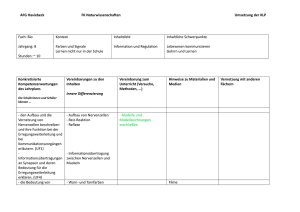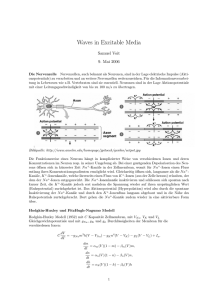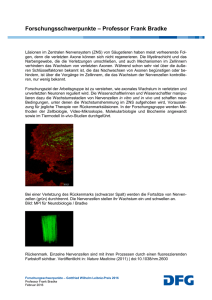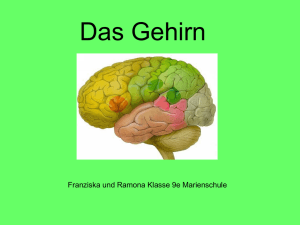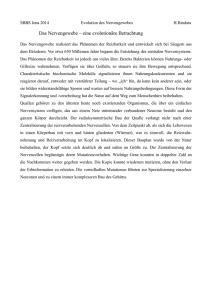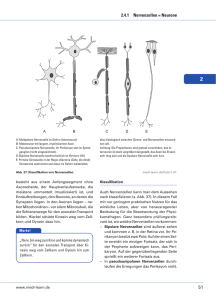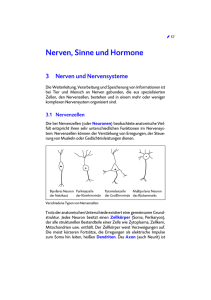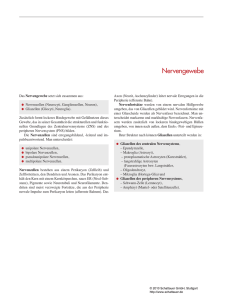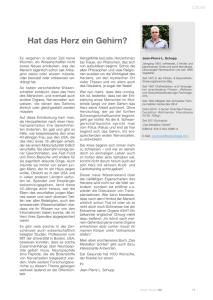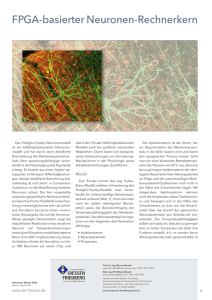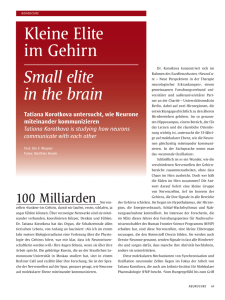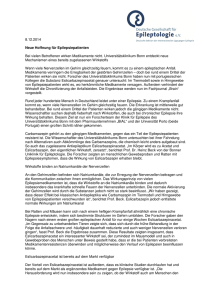Bernstein Newsletter - Homepage.ruhr-uni
Werbung
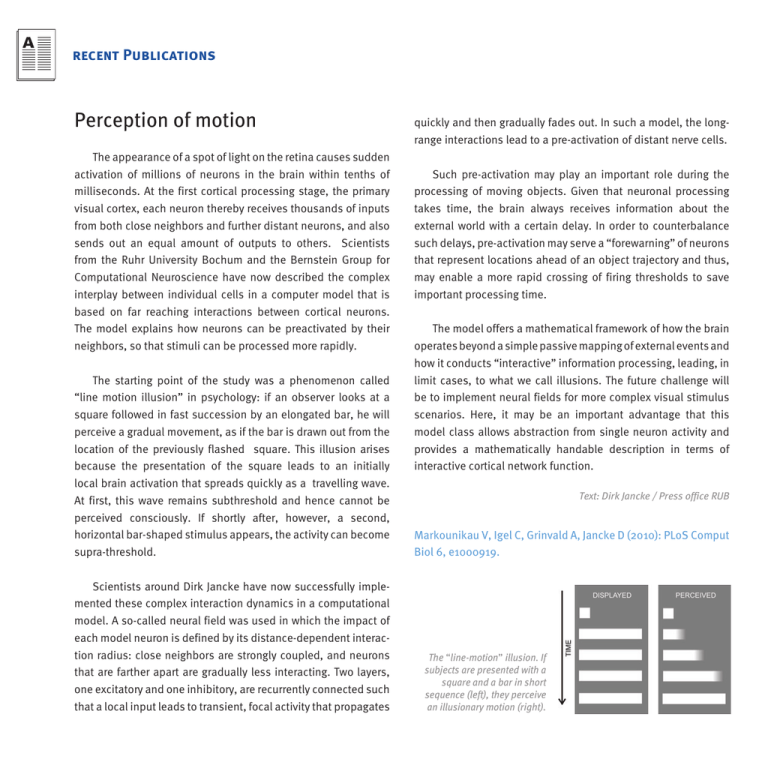
recent Publications Perception of motion The appearance of a spot of light on the retina causes sudden activation of millions of neurons in the brain within tenths of milliseconds. At the first cortical processing stage, the primary visual cortex, each neuron thereby receives thousands of inputs from both close neighbors and further distant neurons, and also sends out an equal amount of outputs to others. Scientists from the Ruhr University Bochum and the Bernstein Group for Computational Neuroscience have now described the complex interplay between individual cells in a computer model that is based on far reaching interactions between cortical neurons. The model explains how neurons can be preactivated by their neighbors, so that stimuli can be processed more rapidly. The starting point of the study was a phenomenon called “line motion illusion” in psychology: if an observer looks at a square followed in fast succession by an elongated bar, he will perceive a gradual movement, as if the bar is drawn out from the location of the previously flashed square. This illusion arises because the presentation of the square leads to an initially local brain activation that spreads quickly as a travelling wave. At first, this wave remains subthreshold and hence cannot be perceived consciously. If shortly after, however, a second, horizontal bar-shaped stimulus appears, the activity can become supra-threshold. Scientists around Dirk Jancke have now successfully implemented these complex interaction dynamics in a computational model. A so-called neural field was used in which the impact of each model neuron is defined by its distance-dependent interaction radius: close neighbors are strongly coupled, and neurons that are farther apart are gradually less interacting. Two layers, one excitatory and one inhibitory, are recurrently connected such that a local input leads to transient, focal activity that propagates quickly and then gradually fades out. In such a model, the longrange interactions lead to a pre-activation of distant nerve cells. Such pre-activation may play an important role during the processing of moving objects. Given that neuronal processing takes time, the brain always receives information about the external world with a certain delay. In order to counterbalance such delays, pre-activation may serve a “forewarning” of neurons that represent locations ahead of an object trajectory and thus, may enable a more rapid crossing of firing thresholds to save important processing time. The model offers a mathematical framework of how the brain operates beyond a simple passive mapping of external events and how it conducts “interactive” information processing, leading, in limit cases, to what we call illusions. The future challenge will be to implement neural fields for more complex visual stimulus scenarios. Here, it may be an important advantage that this model class allows abstraction from single neuron activity and provides a mathematically handable description in terms of interactive cortical network function. Text: Dirk Jancke / Press office RUB Markounikau V, Igel C, Grinvald A, Jancke D (2010): PLoS Comput Biol 6, e1000919. The “line-motion” illusion. If subjects are presented with a square and a bar in short sequence (left), they perceive an illusionary motion (right). Aktuelle Publikationen Wahrnehmung bewegter Bilder Fällt ein Lichtreiz auf die Netzhaut des Auges, werden innerhalb von wenigen Zehntel Millisekunden Millionen von Nervenzellen im Gehirn aktiviert. Jede Nervenzelle in der primären Sehrinde erhält dabei mehrere Tausend Signale sowohl von benachbarten als auch von weit entfernten Zellen, und sendet ebenso viele Signale aus. Wissenschaftler der Ruhr-Universität Bochum und der Bernstein Gruppe für Computational Neuroscience ist es nun gelungen, das komplexe Zusammenspiel verschiedener Zellen in einem Computermodell zu beschreiben, das auf weitreichenden Interaktionen zwischen Nervenzellen aufbaut. Das Modell erklärt unter anderem, wie Nervenzellen von Nachbarn „vorgewarnt“ werden, so dass sie Reize schneller verarbeiten können. Ausgangspunkt für die Forschungen ist ein Phänomen, das die Wahrnehmungspsychologie „line motion“-Illusion nennt: bekommt ein Betrachter kurz hintereinander ein Quadrat und ein langgezogenes Rechteck gezeigt, nimmt er eine graduelle Bewegung wahr, als ob sich das Quadrat zu einem Rechteck streckt. Die Illusion kommt dadurch zustande, dass die Präsentation des Quadrates eine lokale Aktivierung im Gehirn auslöst, die sich rasch wellenförmig ausbreitet. Diese Aktivitätswellen sind zum größten Teil unterschwellig und daher nicht wahrnehmbar. Nur wenn kurze Zeit später ein zweiter, balkenförmiger Lichtreiz erscheint, wird die Aktivitätswelle nach und nach überschwellig. Wissenschaftlern um Dirk Jancke gelang nun die Darstellung dieser komplexen Interaktionsdynamiken in einem Computermodell. Sie nutzten dazu ein neuronales Feld, in dem simulierte Nervenzellen durch die Reichweiten ihrer Wechselwirkungen beschrieben werden: Eng benachbarte Zellen sind durch starke, weiter entfernte durch schwache Kopplungen charakterisiert. Zwei Schichten dieser Nervenzellgruppen, eine erregende und eine hemmende Schicht, sind so verschaltet, dass ein lokaler Erregungseingang eine sich schnell ausbreitende und wieder abklingende Aktivierung erzeugt. Im diesem Modell führen die weitreichenden Wechselwirkungen zu einer Voraktivierung entfernter Nervenzellen. Solche Voraktivierungen könnten eine wichtige Rolle bei der Verarbeitung bewegter Objekte spielen. Denn durch neuronale Verarbeitungszeiten erfährt das Gehirn von Ereignissen in der Außenwelt stets mit Verzögerung. Dank der weitreichenden Interaktionen werden Nervenzellen gewissermaßen „vorgewarnt“, sind schneller aktivierbar und können dadurch wertvolle Verarbeitungszeit einsparen. Das Modell bietet eine mathematische Beschreibungsebene, die es erlaubt darzustellen, wie das Gehirn externe Ereignisse nicht nur abbildet, sondern durch Wechselwirkung zwischen Nervenzellen „interaktive“ Informationsverarbeitung betreibt und in bestimmten Grenzfällen das erzeugt, was wir Illusionen nennen. Die wichtige zukünftige Herausforderung ist der Einsatz solcher Modelle für komplexere visuelle Reizkonstellationen. Ein wesentlicher Vorteil des Konzepts könnte dabei sein, weitreichende Gehirnprozesse von der Aktivität einzelner Nervenzellen zu abstrahieren und so Funktionen des gesamten Netzwerkes mathematisch handhabbar zu machen. Text: Dirk Jancke / Pressestelle RUB Die „line-motion”-Illusion. Zeigt man Probanden in kurzer Folge ein Quadrat und einen Balken (links), nehmen sie eine ScheinBewegung wahr (rechts). Markounikau et al. (2010): PLoS Comput. Biol. 6, e1000919
